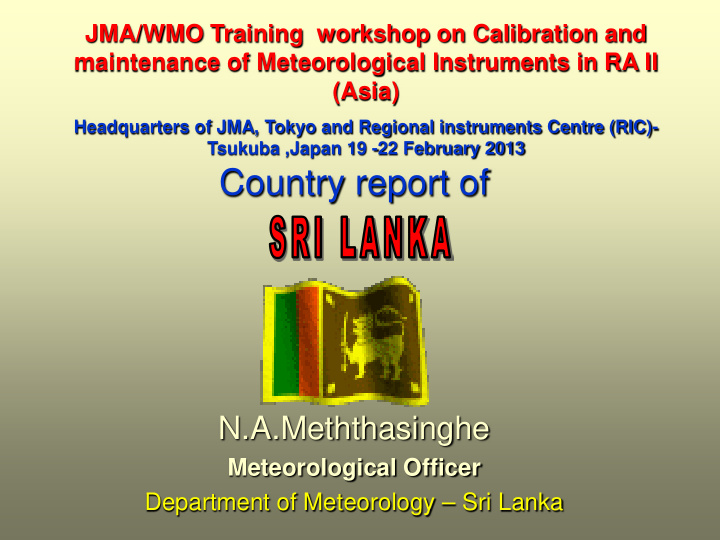



JMA/WMO Training workshop on Calibration and maintenance of Meteorological Instruments in RA II (Asia) Headquarters of JMA, Tokyo and Regional instruments Centre (RIC)- Tsukuba ,Japan 19 -22 February 2013 Country report of N.A.Meththasinghe Meteorological Officer Department of Meteorology – Sri Lanka
Land Area: 65,610 Sq. km Population: 19.6 Million Pop. Density: 309 per sq.km Literacy rate: 91.8 % Ethnic Mix:- Sinhalese: 74 % Tamil: 18 % Muslim: 7 % Others: 1 %
TSUNAMI death toll > 31,000 missing > 6,000 homeless > 450,000
Worst Train Tragedy in the History
Natural Beauty
Highlands of Sri Lanka
Golden Beaches………..
Scenic Beauty
Buddhism is the religion of most Sri Lankans
Elephants In Sri Lanka
Elephant Orphanage Pinnawela, Sri Lanka The original objective of establishing the orphanage inclined more towards tourism, but is soon became a conservation and educational centre. With the help of local and foreign elephant experts, Pinnawela started a scientific captive-breeding programme for elephants.
Sri Lanka’s hill capital KANDY (488 m from the msl) is, perhaps, its most beautiful town. The focal point of the town is the golden- roofed Dalada Maligawa, where the sacred tooth relic of the Buddha is enshrined.
Kandy Esala Perahara or the Annual Pageant of the Temple of Tooth Relic
Dancers at the Kandy Esala Perahera
Sri Lanka is famous for its ….TEA …. Tea, rubber, and coconut exports dominated commercial activity in the country up to 1970s.
Topography and Climate Topography: Between 5 o 55' to 9 o 51' North latitude Between 79 o 42' to 81 o 53' East longitude Characterized by South Central Highlands Mt. Pidurutalagala – 2524 m a msl Mild Climate Average Rainfall: 1860 mm/year Range of rainfall: 950 – 6000 mm Mean Temperature: 27.5 C (lowlands) Lower Temperatures in the highlands
CLIMATOLOGICAL SEASONS • There are four Climatological Seasons • Southwest Monsoon (May to September) • Northeast Monsoon (December to February) • 1 st Inter Monsoon (March & April) • 2 nd Inter Monsoon (October & November)
Meteorological 22 Principal Meteorological Stations Station 38 Agrometeorological Stations Network 375 Raingauge Stations
38 automated weather stations
AWOS
IMPROVED OBSERVATION NETWORK WITH 38 AWS
Upper Air Observations – Pilot Balloon
Upper Air Observations – Radar/Radiosonde
Surface observation • The 22 meteorological offices, observing Atmospheric pressure, air temperature humidity, wind direction and speed,cloud conditions, visibility, weather. • These data used for weather forecasting; are also archived and processed for climatological values. Upper air observation • Three times a day, Pilot balloons ; from Colombo, Mannar, Polonnaruwa, Hambantota • Once a day, Radar Radiosond balloon ; from National Meteorological Centre (NMC) at Colombo around 16:30 SLST. It reads atmospheric pressure, temperature, relative humidity and winds.
Instruments used in measurements Pilot balloon observations :- Optical theodolite Garat German Upper air observations :- Radar equipment Japan Radiosonde equipment Japan Sun shine :- Campbell stokes sun shine recorder Mk IV England Global radiation :- Pyranometer USA with NRG data logger Air Temperature :- Ordinary thermometer Maximum thermometer England Minimum thermometer Temperature range -20 o C to 55 o C
:- Temperature range -10 o C to 55 o C Soil Thermometers England Wind :- Cup counter Anemometer Casella,Munro England Electrical Anemograph MK IV Munro England Wind Vane Locally made Pressure :- Barometer kew type England, South Africa Digital Barometers Casella, England CPG 2400 mensor USA Self recording instruments :- Barograph Open scale, Micro England, Japan, Germany,USA Thermograph England, Japan, Germany Hygrograph England, Japan, Germany Evaporation :- Class A evaporation pan Locally made
Role of Instrument Division • Maintenance & calibration of instruments with the conformity of standards of practices and providing of calibrated instruments to observation centers. • Routine inspections of all instruments at meteorological stations, agrometeorological stations and rainfall stations. • Make arrangements to prepare necessary supporting equipments and the housing for the meteorological instruments.
Testing, calibrating and Comparision of Instruments
Recommend
More recommend